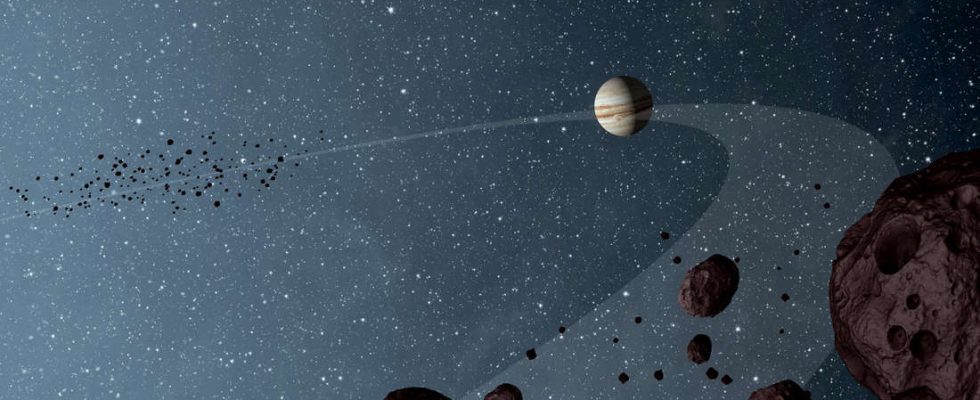On its journey through space, the NASA probe “Lucy” makes an exciting discovery at its first destination: the asteroid Dinkinesh is not alone.
Washington DC – In October 2021, the NASA probe “Lucy” started its mission to the Trojan asteroids near Jupiter. She has now reached her first destination on this long expedition and made an unexpected discovery: the asteroid “Dinkinesh”, which “Lucy” flew past, consists of not just one, but two asteroids.
“Dinkinesh has truly lived up to his name; “This is wonderful,” said Hal Levison, lead scientist on the “Lucy” mission. He refers to the translation of Dinkinesh from the Amharic language, which means “wonderful.” Until “Lucy” briefly visited, “Dinkinesh” was just a fuzzy point in astronomers’ telescopes. Since February 2023, it has been one of the destinations that “Lucy” is heading to on her journey to the Jupiter Trojans.
| Dinkinesh (+ Companion) |
| 52246 Donaldjohanson |
| 3548 Eurybates and satellite QUEta |
| 15094 Polymele and satellite Shuan |
| 11351 Leucus |
| 21900 Orus |
| 617 Patroclus and Menoetius |
NASA’s “Lucy” probe is scheduled to fly past a total of eleven celestial bodies
“When ‘Lucy’ was originally selected for the flight, we planned to fly past seven asteroids. With the addition of Dinkinesh, two Trojan moons and now this satellite, we have increased the number to eleven,” Levison said in one Announcement from NASA.
A few weeks before “Lucy” arrived at Dinkinesh, the mission team had suspected that it could be a double asteroid. The instruments of “Lucy” registered changes in brightness during the approach to the asteroid that indicated this. And the first images of the meeting in space removed any doubts: Dinkinesh is a double asteroid. NASA scientists estimate that the larger of the two asteroids measures around 790 meters at its widest point, while the smaller one has a diameter of around 220 meters.

Visit to asteroid Dinkinesh was a test for “Lucy”
In addition to the surprising discovery in space, the encounter between “Lucy” and Dinkinesh was, above all, a test for the probe: Are all systems working? Can “Lucy” autonomously track an asteroid that she flies past at 16,000 kilometers per hour using the so-called “Terminal Tracking System”? Both NASA and Lockheed Martin, the manufacturer of “Lucy,” are very satisfied with the initial results.
“This is an exciting series of images. “It shows that the terminal tracking system worked as planned, even when the universe presented us with a more difficult target than we expected,” said Tom Kennedy of Lockheed Martin. “It’s one thing to simulate, test and practice. It’s a whole other thing to see what actually happens.”
Researchers are excited about Dinkinesh data
Although the visit to Dinkinesh was originally only intended as a test, the scientists involved are enthusiastic about the data collected. “We knew this would be the smallest main belt asteroid ever seen up close,” says Keith Noll. “The fact that there are two makes it even more exciting.” The NASA employee draws parallels to the double asteroids Didymos and Dimorphos, which the NASA probe “Dart” visited about a year ago to carry out a test for the planetary to carry out defense. “But there are also some really interesting differences that we will investigate,” notes Noll.
The “Lucy” space probe has a tight program planned for the next few years: in December 2024 it will approach the Earth again to use its gravity to gain momentum. It will then fly into the asteroid belt between Mars and Jupiter, where “Lucy” is scheduled to fly past the approximately four-kilometer-large asteroid 52246 Donaldjohanson in April 2025.
Space probe “Lucy” is to visit the Trojan asteroids near Jupiter
The probe will then turn to its main target, the Trojan asteroids, which are in Jupiter’s orbit. The first flyby of the first Trojan, (3548 Eurybates), is scheduled for August 2027. “Lucy” will not visit its last asteroid until 2033. (tab)
Machine assistance was used for this article written by the editorial team. The article was carefully checked by editor Tanja Banner before publication.

